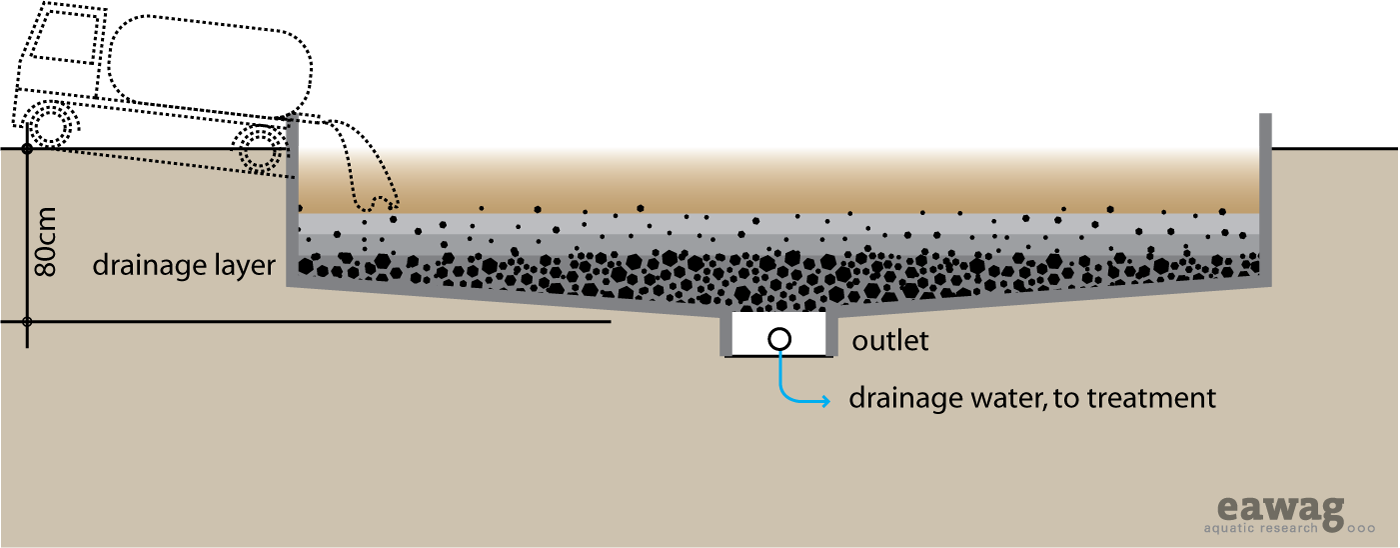Unplanted Drying Beds
|

|
|
| |||||||||||||||||||||||||||||||
An Unplanted Drying Bed is a simple, permeable bed that, when loaded with sludge, collects percolated leachate and allows the sludge to dry by evaporation. Approximately 50% to 80% of the sludge volume drains off as liquid. The sludge however, is not stabilized or treated.
The bottom of the drying bed is lined with perforated pipes that drain away the leachate. On top of the pipes are layers of sand and gravel that support the sludge and allow the liquid to infiltrate and collect in the pipe. The sludge should be loaded to approximately 200kg TS/m2 and it should not be applied in layers that are too thick (maximum 20cm), or the sludge will not dry effectively. The final moisture content after 10 to 15 days of drying should be approximately 60%. A splash plate should be used to prevent erosion of the sand layer and to allow the even distribution of the sludge. When the sludge is dried, it must be separated from the sand layer and disposed of. The effluent that is collected in the drainage pipes must also be treated properly. The top sand layer should be 25 to 30cm thick as some sand will be lost each time the sludge is manually removed.
| Advantages | Disadvantages/limitations |
|---|---|
| - Can be built and repaired with locally available materials - Moderate Capital Cost; low operating Cost. - Potential for local job creation and income generation. - No electrical energy required. |
- Requires large land area. - Odours and flies are normally noticeable. - Long storage times. - Requires expert design and operation. - Labour intensive removal. - Leachate requires secondary treatment. |
Adequacy
Sludge drying is an effective way of decreasing the volume of sludge, which is especially important when it requires transportation elsewhere for direct use, Co-composting, or disposal. The technology is not effective at stabilizing the organic fraction or decreasing the pathogenic content.
Sludge drying beds are appropriate for small to medium communities with populations up to 100,000 people and there is inexpensive, available space that is far from homes and businesses. It is best suited to rural and periurban areas. If it is designed to service urban areas, it should be on the edge of the community.
The sludge is not hygienized and requires further treatment before disposal. Ideally this technology should be coupled with a Co-Composting facility to generate a hygienic product. Trained staff for operation and maintenance is required to ensure proper functioning.
This is a low-cost option that can be installed in most hot and temperate climates. Excessive rain may prevent the sludge from properly settling and thickening.
Health Aspects/Acceptance
The incoming sludge is pathogenic, so workers should be equipped with proper protection (boots, gloves, and clothing). The thickened sludge is also infectious, although it is easier to handle and less prone to splashing and spraying. The pond may cause a nuisance for nearby residents due to bad odours and the presence of flies. Therefore, the pond should be located sufficiently away from urban centres.
Maintenance
The Unplanted Drying Bed should be designed with maintenance in mind; access for humans and trucks to pump in the sludge and remove the dried sludge should be taken into consideration. Dried sludge must be removed every 10 to 15 days. The discharge area must be kept clean and the effluent drains should be flushed regularly. Sand must be replaced when the layer gets thin.
Acknowledgements
The material on this page was adapted from:
Elizabeth Tilley, Lukas Ulrich, Christoph Lüthi, Philippe Reymond and Christian Zurbrügg (2014). Compendium of Sanitation Systems and Technologies, published by Sandec, the Department of Water and Sanitation in Developing Countries of Eawag, the Swiss Federal Institute of Aquatic Science and Technology, Dübendorf, Switzerland.
The 2nd edition publication is available in English. French and Spanish are yet to come.
References and external links
- Crites, R. and Tchobanoglous, G. (1998). Small and Decentralized Wastewater Management Systems. WCB and McGraw-Hill, New York, USA.
- Heinss, U. and Koottatep, T. (1998). Use of Reed Beds for Faecal Sludge Dewatering – A Synopsis of Reviewed Literature and Interim Results of Pilot Investigations with Septage Treatment in Bangkok, Thailand. UEEM Program Report, AIT/EAWAG, Dübendorf, Switzerland. (Comparison to planted drying beds.)
- Montangero, A. and Strauss, M. (2002). Faecal Sludge Treatment. Lecture Notes, IHE Delft. Available: www.sandec.ch
- Tchobanoglous, G., Burton, F.L. and Stensel, H.D. (2003). Wastewater Engineering: Treatment and Reuse, 4th Edition. Metcalf & Eddy, New York.
